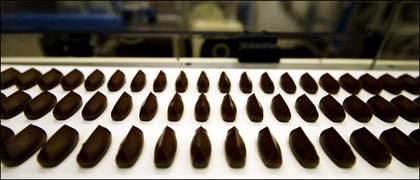|
In Turin, chocolate's the champion
(New York Times)
Updated: 2006-02-15 11:27
THE streets of Turin may be overflowing with Olympics visitors for a few
weeks, but they always overflow with chocolate. Perhaps in no other place in the
world, and certainly no other city in Europe, do so many pastry shops and
chocolate-makers roast and blend their own cacao beans. The cafes of Turin,
still the world's most sumptuous and beautiful, are famous for serving the
city's own hot-chocolate-and-espresso drink called bicerin, a fabulous layered
concoction served in glass cups. It's easy to stroll down the arcaded shopping
streets and sample bars and fancifully shaped pralines wrapped in foil and
colored papers with appealing Art Nouveau designs.

The Guido Gobino
chocolate factory churning out its version of giandujotto, a specialty of
Turin. |
But the chocolate par excellence — the one that says Turin to the rest of
Italy — is the foil-wrapped mini-ingot called giandujotto. Biting into one isn't
like eating any other kind of chocolate. The flavor of roasted hazelnuts comes
through every bite, with the fruity high notes of fine Central American
chocolate in the city's best. The depth of the hazelnuts balances the fruit of
the chocolate, and anchors an experience that with the vinification of chocolate
has become all too ethereal.
The mysterious potency and semi-addictiveness of the combination is familiar
to anyone who has smeared Nutella on bread or simply dipped a spoon into a jar
of it. Gigi Padovani, a journalist for La Stampa of Turin and author of a brisk
history, "Nutella, un Mito Italiano" ("Nutella, an Italian Myth," Rizzoli,
2004), calls the spread the "good blob."
Nutella conquered the world soon after it was invented in Piedmont, the
northwestern Italian region of which Turin is the capital, and went onto the
market in 1964. But the combination of hazelnut and chocolate predated Nutella
by a couple of centuries, and, like much brilliant inspiration, was born of
necessity.
By the late 18th century (about 150 years after Cortes had introduced
chocolate to Spain in 1528) Turin was an international chocolate capital, thanks
to trade relations between the ruling House of Savoy and the Spanish court.
Turin's chocolate producers exported 750 pounds a day to Austria, Switzerland,
Germany and France, according to Sandro Doglio's "Il Dizionario di Gastronomia
del Piemonte" ("The Dictionary of Piedmont Gastronomy," Daumerie, 1995). Swiss
chocolate-makers came to Turin to learn their trade.
But supplies of chocolate from the New World became irregular during a naval
blockade imposed by Napoleon in 1806 (the French then ruled Piedmont), and the
city's chocolate-makers had to look to local products as surrogates. The world's
sweetest, most prized hazelnuts grow in the misty hills of the Alta Langa, the
southern region of Piedmont around Alba. Roasted and ground with chocolate, the
nuts helped the chocolate-makers stretch a scarce import.
|